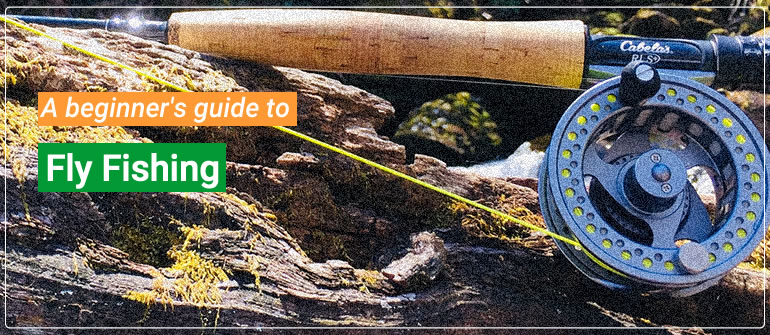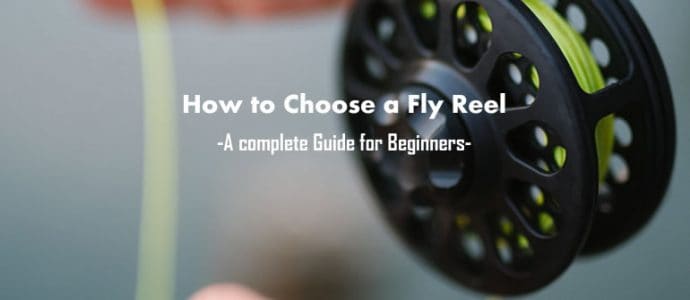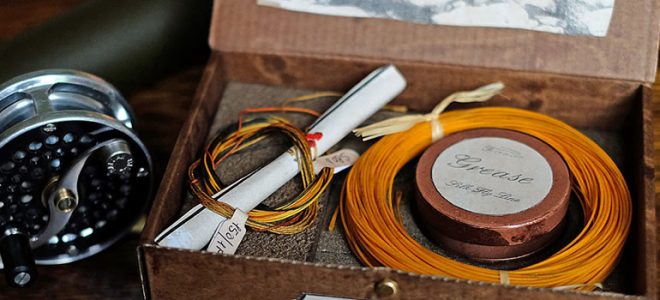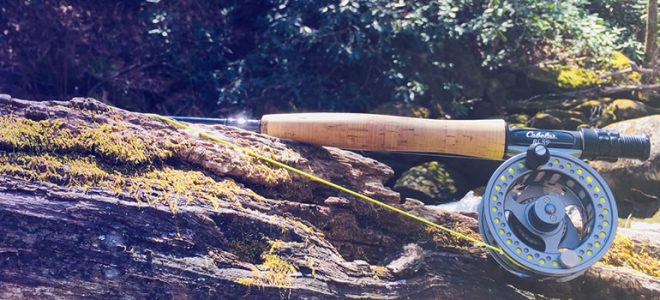If you buy via a link on this page, we may receive a commission, at no extra cost to you.Learn more

Unknown to many fly fishermen, the ancient art of fly fishing actually began with the Greeks and was continued by the Romans according to historical writings. However, fly fishing as we know it today was actually developed by English anglers who observed their native Brown Trout feeding on May and Caddis flies in their local chalk streams.
In fact, the modern art of fly fishing can actually be credited to an English Prioress named Dame Julia Berner who wrote something called The Treatyse on Fysshynge with an Angle which was published in 1496 in The Boke of St. Albans.
Types of Fly Fishing
Fortunately for modern anglers, the art of fly fishing has since evolved into a very sophisticated sport accompanied by very sophisticated equipment which enables modern fly anglers to pursue and catch nearly any fish species on Earth.
Consequently, modern fly fishermen commonly divide fly fishing into two main categories consisting of freshwater fly fishing and saltwater fly fishing and then, they further sub-divide these two main categories into more specific categories. For instance, a freshwater fly fisherman can choose to fish on moving water such as a river or stream or, they can choose to fish still water such as a lake or pond. In addition, they can also choose to fish small streams, large streams (aka “big water”) or, rivers as well as fishing on ponds, small lakes, or large lakes.
On the other hand, a saltwater fly fisherman can choose to fish inshore or offshore waters and, those that choose to fish inshore waters can choose to fish in mangrove swamps, saltwater marshes, estuaries, shorelines, shallow sounds and, the surf zone while those that choose to fish in deep offshore waters can pursue pelagic fish species.
Furthermore, due to the significant evolution of fly rods, fly lines, fly patterns and, fly fishing techniques, a modern fly fisherman can now choose to fish both on the surface and well below it to pursue and catch nearly any fish species that will strike a lure. Thus, modern fly fishing equipment manufacturers have risen to this challenge by providing the angler with the specialized fly rods, fly reels, and fly lines they need to pursue their favorite fish species wherever they live.
So, in order to provide a more detailed explanation of the different types of fly fishing, let’s examine each type fly fishing environment in greater detail.
Freshwater Fly Fishing
As mentioned above, freshwater fly fishing is commonly divided into two main categories consisting of moving water and still water. However, the reason that fly fishermen make this distinction is because these two environments are very different from each other and thus, they require different equipment and different techniques to catch the fish species that inhabit them.
Fly Fishing on Moving water
When most modern anglers think of fly fishing, they tend to automatically envision wading in a stream of moving water while casting their fly to various trout lies. However, to the avid fly fishermen, fly fishing on moving water encompasses many different types of fly fishing ranging from pursuing miniature brook trout in tiny mountain streams to battling huge salmon in large rivers as they return from the sea to spawn and each type of fly fishing is considered to be a highly specialized sport.
Small stream fly fishing
Small stream fly fishing is unlike fishing large streams or rivers because it not only requires a specialized fly rod and fly line, it also requires the fly angler to adopt the mindset of a hunter rather than that of an angler. Consequently, experienced small stream fly fishermen learn to carefully conceal their presence from their prey by using any available cover such as logs, rocks, boulders, and streamside foliage while stealthily stalking their prey.
In addition, they purposely choose both their fly rods and their fly lines to match the purpose. For instance, because of small stream fly fishermen commonly fish in tight quarters surrounded by streamside foliage, cast over short distances and, catch relatively small fish, they most often choose relatively short fly rods with slow actions designed to cast light fly line weights. In addition, they also commonly choose floating fly lines with specialized tapers which they combine with short tapered leaders.
Large stream fly fishing
Fly fishing large streams, on the other hand, is an entirely different type of fly fishing which requires different equipment. For instance, rather than closely approaching a probable trout lie and thus, having to conceal their presence, large stream fly fisherman instead prefers to cast over much longer ranges which serve to conceal their presence from prospective prey due to a law of physics called Snell’s Law. Therefore, large stream fly fisherman generally chose much longer fly rods with either medium or fast actions which are designed to cast much heavier fly lines which they combine with significantly longer tapered leaders.
In addition, because large stream fly fishermen generally pursue larger fish, they commonly use larger flies as well as both surface and subsurface fly patterns. Therefore, they may choose either a floating line, a sinking fly line or, a sink-tip fly line depending on the type of fly pattern they are presently using and the depth of the water.
Plus, they also use different fly casting techniques from small stream fly fishermen and thus, they commonly employ two techniques called the Single Haul and the Double Haul.
Fly Fishing on large rivers
There again, although fly fishing on large rivers is similar to fly fishing on large streams, fly fishing large rivers often requires a fly fisherman to cast over significantly longer distances and to battle much larger fish.
Therefore, fly fishermen who fish large rivers sometimes use significantly longer fly rods than large stream fly fishermen and these specialized fly rods are called “switch rods” and “spey rods” and they commonly measure between twelve and fifteen feet.
Therefore, fly fishermen who use switch and spey rods also use specialized fly lines which are specifically designed for optimal performance when used with these specialized fly rods as well as high capacity fly reels with large arbors and sophisticated disc drag systems.
Fly Fishing on Still Water
On the other hand, the practice of fly fishing on still water has gained tremendous popularity in recent years as fly anglers have discovered that their favorite stillwater fish species will often gobble a fly as readily as they will a lure. Also, fly fishing equipment manufacturers have made tremendous strides in recent years by introducing both fly rods and fly lines that are specifically tailored to the many different freshwater fish species that inhabit still waters.
Consequently, fly fishermen who want to fish still waters are no longer limited to casting tiny dry flies to wary trout in clear mountain lakes. Instead, they can now target such species as largemouth and smallmouth bass, carp, pike, muskie or, just about any other scaly torpedo that you can name.
However, due to the depth of the water in most freshwater ponds and lakes, fly fishermen need to be able to pursue their prey both on the surface and at deeper depths and thus, stillwater fly fishermen can choose between floating and sinking fly lines with a wide range of specialty fly line tapers and decent rates.
Surface fly fishing on still water
Most fly fisherman, regardless of whether they prefer to fish on moving water or still water, consider surface fishing to be the single most exciting method of fly fishing because surface fishing enables the angler to see the fish strike their fly.
Therefore, stillwater fly fishermen can use floating fly lines to cast may fly patterns to rising trout one day and cast large, hairy, “bass bugs” to largemouth bass the next day simply by switching their fly rods, their fly lines, and their fly patterns.
Sub-surface fly fishing
However, most fish that inhabit ponds and lakes most often feed well below the surface and thus, by switching to a sinking fly line with an appropriate rate of decent, fly fishermen can also use various types of subsurface fly patterns such as nymphs or streamers to catch their chosen fish species.
In fact, there are now fly lines available with decent rates ranging from one to two inches per second to as much as six inches per second. Therefore, a modern fly fisherman can now cause his fly to hover just under the surface or sink to depths of thirty feet or more to target fish where they are holding at any given time of day or time of year.
Saltwater Fly Fishing
As mentioned above, saltwater fly fishing can also be divided into several different categories consisting of mangrove swamps and saltwater marshes to estuaries, shorelines, shallow sounds, flats, and the surf zone in addition to offshore waters. Therefore, the saltwater environment is every bit as dynamic as the freshwater environment is and thus, saltwater fly fishermen also choose fly rod, fly reels, and fly lines specifically tailored to the type of saltwater environment that they intend to fish as well as both the type and size of the fish they intend to pursue.
Fly fishing mangrove swamps
Fly fishing in mangrove swamps generally requires precision casting and a more delicate presentation than other types of saltwater fly fishing. Thus, fly fishermen who pursue fish in this environment commonly choose fly rods designed to cast relatively light fly lines with tapers that are specifically designed to land gently on the water so that they do not spook the fish that inhabit these clear, shallow, waters.
Fly fishing in estuaries
Somewhat similar to fly fishing in mangrove swamps, fly fishing in marshy estuaries also often requires precision casting but, generally over much longer distances with a less delicate presentation.
Therefore, fly fishermen who commonly fish in estuaries generally chose slightly heavier fly lines than those who fish mangrove swamps because they also commonly fish with somewhat larger fly patterns and often have to battle with the wind in order to land their flies where they want them.
Fly fishing sounds
The fish species that commonly inhabit sounds are often somewhat different than those that inhabit estuaries and thus, saltwater fly fishermen must adapt both their fly selections and their fishing techniques accordingly.
Thus, while surface fly fishing can be productive in sounds, most fly fishermen pursue their prey below the surface using either sink-tip fly lines or sinking lines and fly patterns that imitate crustaceans and baitfish.
Fly fishing the surf zone
Because surf fishing involves an ability to read the beach in order to find “holes” and “rip currents” where fish hold in order to feed, fly fishing in the surf zone can be somewhat difficult. But, it is by no means impossible or unproductive.
However, just like fly fishermen who fish large rivers, fly fishermen who fish the surf zone also often have a need to cast over relatively long distances as well as the need to deal with strong currents.
Therefore, fly rod manufacturers have responded to the demand for surf-specific fly rods by providing fly fishermen with fly rods that have extremely powerful actions combined with both floating and sinking “shooting head” fly lines as well as fly patterns that closely imitate the worms, crustaceans, and baitfish species that commonly inhabit the surf zone.
Fly Fishing the Flats
While fly fishing in the surf zone can be a very exciting experience and does not require an angler to own a boat, fly fishing the flats holds a different type of appeal for most fly fishermen. For instance, although some flats can be reached by wading out from shore, the most productive flats tend to be those that are the most remote and thus, they usually require a boat of some sort to reach them.
Consequently, fly anglers have adopted both the “flats boat” or “flats skiff” as well both “sit-on-top” and “sit-inside” sea kayaks as a means of reaching the fish species that visit the flats at high tide to feed. In addition, they commonly employ a method of fly fishing called “sight fishing” where they first spot the fish that they intend to cast to before presenting their fly to the fish.
But, regardless of how you choose to get there, once you arrive armed with your favorite fly rod and an appropriate selection of “flats flies”, you could arguably be said to have the ultimate means of delivering an enticing imitation of a natural food source to ultra wary saltwater fish in clear, shallow, water.
Offshore Fly Fishing
Last, there is a final type of saltwater fly fishing called offshore fly fishing. However, this type of fly fishing is vastly different from inshore fly fishing in that it is more akin to conventional fishing methods than any other type of fly fishing.
In fact, when fly fishing offshore for pelagic fish species, the most common method employed is to troll with multiple “teasers” in the water behind the boat until they attract the interest of the quarry and draw it to within casting range.
Then, once the desired prey is spotted, the teaser that caught the fish’s attention is slowly drawn close to the boat’s stern so that the fly fishermen can then cast his fly directly in front of the fish to replace the teaser.
Then, once the fish is firmly hooked, it is fought similar to any other large game fish by employing the reel’s drag system and palming the spool’s rim to stop runs and then, either reeling or stripping the backing and fly line into land the fish.
So, although the modern sport of fly fishing originated as a means of catching large Brown Trout in English chalk streams by tying bits of feather and fur to hand forged iron hooks in order to imitate aquatic insects, the sport of fly fishing has since evolved to encompass fly rods, fly reels, fly lines, and fly leaders made from modern materials which make the sport both far more enjoyable and far more productive.
In addition, due to the fact that fly fishermen now pursue their favorite fish species in both freshwater and saltwater environments as well as several different sub-environments, fly fishing equipment manufacturers have developed specialty fly rods, fly reels, and fly lines to accommodate the many different aspects of this fast-growing sport.
Thus, if you are not yet a fly fisherman but, are the type of person who enjoys a challenge, then perhaps you should consider exploring one or more of the many different types of fly fishing because most fly fishermen agree that fly fishing is far more satisfying than conventional fishing methods and, any fish that will strike a lure will also strike a fly.




